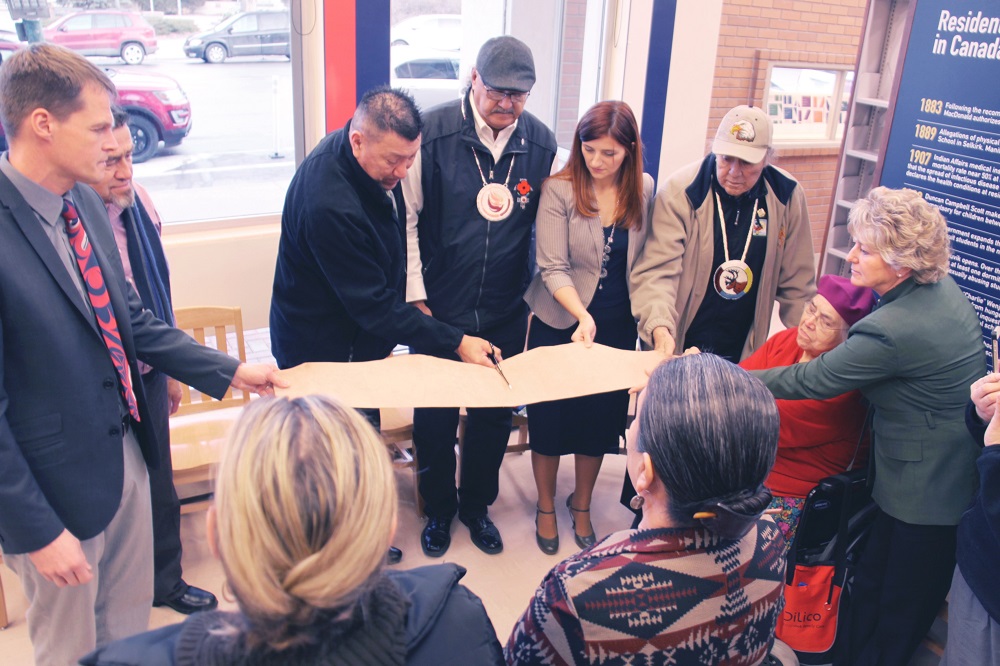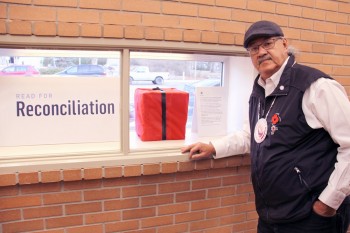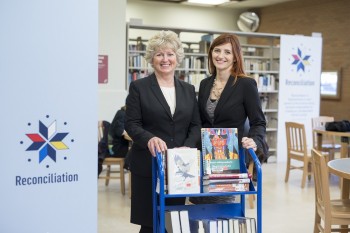Since the last of Canada’s Indian residential schools closed in 1996, the nation has been attempting to shape a response to the legacy of abuse that the residential school system—which removed native children from their homes and families—inflicted on its Indigenous Peoples. Saskatoon Public Library (SPL), Saskatchewan, has become the first public library to incorporate a space permanently dedicated to truth and reconciliation. On November 21 SPL’s Frances Morrison Central Library opened the Read for Reconciliation reading area, which includes a full set of the reports compiled by the TRC over five years, plus a variety of books about Canada’s history of residential schools, as well as an extensive reading list on the history and legacy of residential schools in Canada on its homepage.

Hide cutting at opening of SPL's Reconciliation Reading Area (l-r): Saskatoon Mayor Charlie Clark, Office of the Treaty Commissioner, Executive Director Harry Lafond, Kelly Bitternose (survivor), Eugene Arcand, SPL Board Chair Candice Grant, Elder Walter Linklater, Elder Maria Linklater and Carol Cooley CEO and Director of Libraries for Saskatoon Public Library.
Photo credit: Eagle Feather News
Since the last of Canada’s Indian residential schools closed in 1996, the nation has been attempting to shape a response to the legacy of abuse that the residential school system—which removed native children from their homes and families—inflicted on its Indigenous Peoples. The Truth and Reconciliation Commission of Canada (TRC), established in 2008, spent seven years assembling documentation from survivors and working to build awareness of these abuses, ultimately issuing a series of Calls to Action at the end of 2015. Since that time a number of institutions have implemented programs to advance the national movement toward reconciliation, including the establishment in 2015 of the
National Centre for Truth and Reconciliation (NCTR), hosted by the University of Manitoba, Winnipeg. In February 2016 the University of Saskatchewan joined eight other post-secondary institutions in partnership with NCTR to make some five million electronic records on the subject accessible. Now Saskatoon Public Library (SPL), Saskatchewan, has become the first public library to incorporate a space
permanently dedicated to truth and reconciliation. On November 21 SPL’s Frances Morrison Central Library opened the
Read for Reconciliation reading area, which includes a full set of the reports compiled by the TRC over five years, plus a variety of books about Canada’s history of residential schools, as well as an extensive
reading list on the history and legacy of residential schools in Canada on its homepage. The space currently holds more than 1,200 volumes devoted to reconciliation—adult fiction, nonfiction, and poetry both by and about Indigenous Peoples, as well as information on the history of residential schools and the reconciliation movement and an original boxed copy of the TRC report. This is supplemented by more than 9,000 volumes on the subject within the SPL system. In addition, the space will host programming focusing on healing, truth, and reconciliation. “Other organizations in the community, for instance the school boards and hospitals, have all done work toward reconciliation,” explained SPL director and CEO Carol Cooley. “But it's not as public as a public library can be. We can impact every neighborhood and we can insure that we raise the profile of the issue and continue to educate our public, because even in Canada not a lot of people were aware of residential schools and the impact that they had on our Indigenous population."
“CULTURAL GENOCIDE”
The Indian residential school system was a network of government-funded boarding schools across Canada which housed indigenous children ages six to 15, many of them forcibly removed from their families and tribes, in an attempt to assimilate them into what was then considered the dominant Canadian culture. From 1876, when Canada’s Indian Act was passed, until 1996, approximately 150,000 native children were placed in residential schools. Separated from parents and siblings and forced to abandon their culture, religion, and language, most children in the system received inferior education, nutrition, and health care; physical and sexual abuse was rampant, and parental visits were heavily restricted. An estimated 6,000 students died while in residential schools. The system has been linked to a legacy of post-traumatic stress disorder, alcoholism, substance abuse, chronic medical conditions, and suicide among its survivors. "Apartheid in South Africa was modeled after the residential school system,” said Cooley. “It was a pretty deliberate cultural genocide." The TRC, funded by the 2007 settlement of a class-action lawsuit, was established in 2008 by parties of the Indian Residential Schools Settlement Agreement as part of an ongoing attempt to respond to this trauma. The King’s University College of Edmonton, Alberta, held an interdisciplinary conference on Truth and Reconciliation in January 2008, and that March, Indigenous leaders and church officials toured the provinces to promote the TRC’s formation. In June, Prime Minister Stephen Harper issued a formal public apology on behalf of the Canadian government. Between 2008–13, the TRC gathered statements from survivors across the country. The resulting report collecting these stories and a series of historical documents ran to more than 4,000 pages. With the report’s publication in 2015, the NCTR was established, with the mandate that former students and their families, as well as researchers and the public, have access to the history of the residential schools so that the legacy of colonialism will not be forgotten. It opened in November 2015, and holds both physical material and digital archives. In December 2015, the TRC issued 94
Calls to Action in order to begin to redress the damages in an ongoing way, and to advance the process of Canadian reconciliation.
PARTNERS IN RECONCILIATION

Eugene Arcand
Photo credit: Eagle Feather News
SPL is a partner in Reconciliation Saskatoon, a partnership between the City of Saskatoon, the Office of the Treaty Commissioner, and some 30 community groups. At the first meeting she attended Cooley met Lorna Arcand, who introduced her to her husband, Eugene Arcand, a Cree from the Muskeg Lake First Nation in Saskatchewan who spent 11 years in the residential school system. He has worked with the Saskatchewan First Nations community in a number of capacities for the past 37 years, and is one of ten residential school survivors to represent Saskatchewan on the TRC Survivor Committee, helping to gather testimonies. He currently sits on the TRC governing circle at the University of Manitoba. Cooley invited Arcand to speak at SPL, and while organizing the lecture details, the idea of the Read for Reconciliation room was born. Arcand had been presented with five complete sets of the TRC report and Calls to Action, and he proposed donating one set to the library and establishing a space devoted to reconciliation. Cooley had been considering a similar idea for the library. “So it was a nice dovetailing between our readiness to take those steps and Eugene's desire, as well, to further this cause,” explained Cooley. The space was set up simply, with several tables arranged in a circle, conducive to both research and reflection. The documents donated by Arcand are prominently displayed in a box wrapped in red broadcloth and tied with black ribbon, “to represent the dark era and the blood that was shed,” explained Cooley. The volumes were blessed in a ceremony and are for display only, but the library has full copies of the report and Calls to Action, which can also be
accessed online. (Arcand has also donated copies to SaskPolytechnic, the Greater Saskatoon Catholic School Board, and the Saskatoon Public School Board.) The opening was attended by residential school survivors, as well as Cooley, SPL Board Chair Candice Grant, Saskatoon mayor Charlie Clark, and Office of the Treaty Commissioner Executive Director Harry Lafond. Attendees joined to cut a piece of hide, and Elders Walter and Maria Linklater offered a ceremonial smudge and prayers. The event was an emotional one for many there. “We've been forced to remember in a short period of time what we spent a lifetime trying to forget,” Arcand told
LJ. “That's the best way I can put it." But the library’s contribution to the effort has been met with warm approval. "I'm proud to be a part of working with [SPL staff],” said Arcand. “Because they really do understand. They really do engage. They take our thoughts and our words and implement them and you know, that's a new step in this country." Cooley hopes to bring a digital component to the collection as well. The library is in the process of developing an Indigenous services strategy, as a component of its most recent strategic plan involves honoring Indigenous perspectives. "It is a significant pillar to our plan,” Cooley told
LJ. “We are making a very public commitment to reconciliation, in large part because it is needed and important, but with Saskatchewan our indigenous population is growing and if our province is going to be healthy and vibrant…we need to really put action behind the call to action, rather than just symbolic gestures and words." In addition, Arcand has suggested taking photographs of residential school survivors, displaying them in the library’s gallery, and eventually holding them in SPL’s local history room. Cooley agrees: "Gradually the survivors are going to pass on, and this would be a good way to capture a visual component." For now, however, the area is busy every day. "There's a peacefulness in that space,” said Cooley, describing visitors stopping to catch their breath when they first see it—“not because it's incredibly large, and it's not as beautiful as we would make it in a new central library. But it's a statement."
EMBRACING AWARENESS

SPL director and CEO Carol Cooley and SPL board chair Candice Grant in the Reconciliation Reading area
Photo credit: David Stobbe / stobbephoto.ca
While SPL used no additional funding to establish the space, Cooley told
LJ, the library has a firm commitment to furthering reconciliation awareness. Plans to hire an Indigenous services coordinator are in the works, and SPL will be allocating funds specifically for its Indigenous collection and program development. All SPL employees have taken Aboriginal awareness seminars. The system also recently received approval to double the hours of two branches serving the area’s largest Indigenous populations—one of which is to be renamed for Freda Ahenakew in February. Ahenakew, a Cree mother of 12, returned to high school at the age of 38, and went on to receive several graduate degrees, eventually becoming a researcher of Indigenous languages, prolific academic author, and professor of native studies. She was awarded two honorary Doctorate of Law degrees, a National Aboriginal Achievement Award in Education, and the Order of Canada and the Saskatchewan Order of Merit; at the time of her retirement in 1995, Ahenakew served as the Director of the Department of Native Studies at the University of Manitoba. A new SPL building, completed in December, was named the Round Prairie Branch in honor of the Métis community that originally occupied the area. The Calls to Action for reconciliation are national, Cooley noted, and she feels that other libraries could institute similar programs easily. "I know not all communities have large populations of Indigenous Peoples, but I think it's incumbent upon all of us to understand the impact of residential schools and the intergenerational trauma,” she told
LJ. “I think that understanding helps remove the judgment about Aboriginal Peoples and some of the mental health and substance abuse issues that they face…. I think public libraries, for adult populations, can play that educational role." SPL is also working with the Canadian Federation of Library Associations to create a set of
best practices for libraries that want to initiate reconciliation work. Because of its ongoing work, SPL has been called “the rock star of reconciliation,” said Cooley. “That's great, but I hope one day we get to a place where the library isn't the rock star of reconciliation, and these things aren't so remarkable, but are part of everyday life." “The effects of colonization and…genocide have to be addressed, and have to be addressed by my people, but you can't do it alone,” added Arcand. "We have nowhere to look but up, and look forward to changing things."












Add Comment :-
Comment Policy:
Comment should not be empty !!!